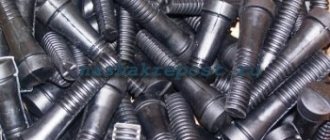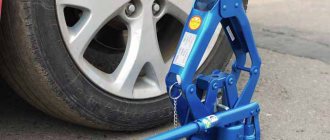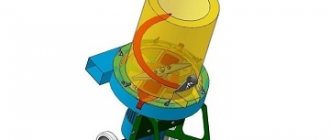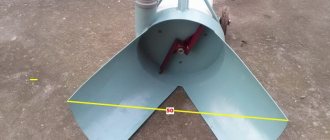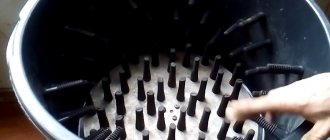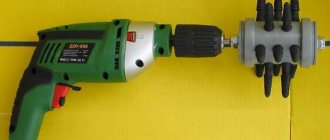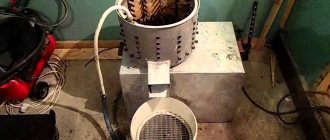Homemade feather removal installation
You can pluck chickens by hand, but you can mechanize the process.
Designed and manufactured a feather removal installation for a regular customer. It is designed to automate the process of de-feathering broilers, laying hens, roosters, turkeys, geese and other farm birds.
It works on the principle of a centrifuge. The lower disk rotates while the drum is stationary.
The installation consists of a frame, a working drum, an electric motor, a bearing unit, and a belt drive.
Frame: welded, made of metal angle. Working drum: diameter 600 mm, made of food-grade polypropylene. Purchased from a store. Disc: made of food grade stainless steel. The installation uses commercially available pen removal pins designed for household pen removal machines.
The advantages of this installation: low cost, ease of maintenance and repair.
Technical characteristics of the installation. Dimensions: length - 1000, width - 700, height - 1200 mm. Number of punching fingers: 110 pcs. Motor: single-phase 220V, 1.5 kW, 1500 rpm. Attaching photo.
The quality of processing is perfect. Carcass processing time is 20 seconds.
It is known: on the farm, it is preferable to buy equipment that has a variety of functions. For example: if you buy a loader, then it must perform various operations in agriculture: load semi-liquid, solid manure; grain, etc. Including, used as a tap. There is a unique tool - a drill-mixer, with which you can drill, prepare a concrete mixture, prepare holes for posts, mix paint, etc. I adapted this drill for no-moldboard tillage - installed it on a homemade electric cultivator, with which you can , without ruining the soil, loosen the soil using the “papillonage” method. By installing a professional drill-mixer with an adjustable speed on a homemade feather removal unit, you can improve the quality of processing poultry carcasses.
Questions:
Equally suitable for birds of all sizes? (From quails to turkeys?) Or should the drum sizes be different for each type of bird? What is the lifespan of these rubber fingers? Wouldn't it be better to make the structure lower, since the height of 1200 mm is not very convenient for work? With such dimensions, how can you clean the installation after work?
Answers:
Regarding the size of the container for different birds. It’s clear: each bird must have its own container size and “its own” fingers. Regarding the resource. I don’t know - I was not involved in the operation of these installations. It’s clear: if you purchase “branded” fingers, the resource will be greater. When purchasing, use paper. If you draw a finger to install it and a mark remains on the paper, then it is better to refuse the purchase. Regarding the height of the structure. The height of the structure can be made significantly smaller. The plastic container has a specific shape. If you cut off the bottom of the container and install a stainless steel tray underneath, the height will be reduced by 150 millimeters. You can cut off the top by 100 mm. You can reduce the distance from the shaft to the zero mark by about 100 - 150 mm. But, the installation was made according to the customer’s requirements at exactly this height. Regarding cleaning. The unit must be cleaned after use with hot water from a hose.
Choosing fingertips
Hello dear farmers! In this article we will look at how to choose the right type and calculate the number of strikers for making your own feather picker or drill attachment.
First, let's look at what beat fingers are (or simply beats, pen fingers).
A hammer pin is a rubber part shaped like a regular pin, with a seating groove from 10 to 25 mm and a length from 50 to 300 mm, depending on the purpose and installation location. The beaters remove the feather due to the frictional force generated when there is contact between the rubber and the bird carcass. They have different shapes of the working surface depending on the type of feather being removed and the type of bird.
The main characteristics of feather fingers are: shape, length, bore diameter, tensile strength, Shore rubber hardness, elasticity and color.
The shapes of the beats are:
To choose the right type of plucking fingers in shape and size, you must know what kind of bird you will be plucking: quail, broilers, chickens, ducks, geese or turkeys.
For quail you need a small finger up to 50mm long and a landing diameter of 10mm. The quail is a small bird, so it is necessary to exclude the possibility of the bird getting stuck between the fingers. If you use fingers 90-100 mm long, the carcasses will fall between the fingers, or these beaters must be installed very often with a minimum distance between them. And this significantly increases the number and, accordingly, the price of purchasing fingers.
Boilers, chickens and turkeys have mostly small feathers, for the removal of which ball-shaped fingers (or spheres) with a length of 90-100mm and a fit with a diameter of 20mm have proven themselves.
Waterfowl ducks, ducks and geese have large feathers, for which ring-shaped fingers (or a ring) with deep ribs, 90-100 mm long and a landing with a diameter of 20 mm work well for plucking. The distance between the ribs of the beel corresponds to the thickness of the pad of the lower part of the feather, which holds the feathers in the skin of the bird.
In order to pluck different birds on one machine, we recommend combining the beating fingers with spheres and ring fingers in equal proportions.
For household centrifuge-type feather removal machines, soft fingers with a value of (48-55 Shore units) are used. In this type of equipment, the bird hits the finger under its own weight; if it is hard, the likelihood of skin tearing increases significantly. For beating drums and feather pick-up attachments, it is also better to use soft fingers, because... It is very difficult to accurately calculate the hand strength with which you need to press the bird to your fingers.
For industrial conveyor lines, stiffer pins with a value of (60-70 Shore units) are used.
The elasticity of rubber is the ability of rubber to quickly return to its original state. In our case, this is the ability to quickly return the finger to its original state when bent.
White rubber fingers have the greatest elasticity. We recommend using it for plucking young poultry. Another property of white rubber is its pleasant smell.
In order to correctly calculate the required number of pins, you need to know what type of equipment they will be installed in. Simply put, decide what you will make: a poultry plucking attachment, a beating drum or a feather picker?
| Feather nozzle | Beat drum | Centrifugal beating machine |
| 15-24pcs | 50-72pcs | 100-250pcs (depending on the diameter of the tank) |
Feather fingers can be made of rubber of varying tensile strength. This value can be from 10-25 mPa. The higher, the more expensive the original rubber and, accordingly, the longer the service life of the finger. For this parameter, select fingers based on the number of poultry heads slaughtered per year. If you slaughter up to 500 pieces/year, take any finger. For large numbers of heads, it is better to take fingers with high strength. This value does not affect the quality of pen removal.
The technological process of removing feathers from a bird also depends on several factors:
- Rotation speed of the feather removal machine or drill attachment;
- Temperature and time for scalding poultry before plucking;
- Choosing the right type of striker fingers.
We hope that this information will help you quickly and efficiently make your own feather picker, poultry plucking attachment or beater drum.
Households very often breed poultry for meat (ducks, geese, broiler chickens, etc.). At the same time, the plucking process is not easy and not very pleasant. It is precisely in order to save owners from such an unpleasant task that a feather removal machine was invented. For use at home, you can make a feather removal machine with your own hands.
The entire range of finger pins from our production -> here
The striking fingers are the working part of the equipment that removes the feathers from the bird. Removal of the feather is achieved by rubbing the feathered surface of the bird against the beaters. In this case, the size, shape and rigidity of the feathering finger depend on the bird that needs to be plucked.
The beating fingers consist of a special rubber, the composition and properties of which vary depending on the characteristics of the bird and the method of plucking (home or industrial).
How to choose hitting fingers?
When choosing strikers for a feather picker, you should consider the differences between them.
The main parameters characterizing the striking fingers:
1. Striker size 2. Shape 3. Tensile strength 4. Softness
For quail, small chicken and other small birds, beaters with a total length of 50 mm are used.
Working length – 45 mm. The pin mounting hole is 10 mm. Landing groove – 2 mm. If the wall thickness of the tank you are using is thinner than 2 mm, you should use washers. The finger should fit tightly. Quail feather pluckers are made of white and black rubber. White rubber plucks the bird more delicately. When working with white fingers, some inaccuracies in scalding and the time spent in the scalding can be tolerated! For example, scald the bird in hotter water or keep it in water for longer than the specified time. Black rubber has standard plucking characteristics. By adhering to technology, you will also get excellent results!
For large birds - chicken, broiler, duck, turkey and goose, feather fingers with a total length of 94-97 mm are used. Working length – 80-85 mm. Mounting hole – 20 mm. Landing groove – 2.2 mm. If the tank wall thickness is thinner than 2.2 mm, you should use washers.
There are two main forms of strikers for large birds:
- ring (finger with horizontal ribs)
- ball (surface of the finger is pimply)
For chicken and broiler - ball-shaped fingers. This shape plucks fluff better and provides a more delicate plucking.
For duck, goose and turkey - ring shape. Ring fingers are better at plucking tougher, larger feathers.
If you keep different birds, then ball and ring fingers can be combined in a 50-50 ratio, staggered.
Tensile strength . Rubber strength should not be confused with stiffness or hardness. The higher the strength, the better the rubber, the more elastic and, accordingly, the longer it will last. We offer pins with a strength of 13 MPa, 20 MPa and 25 MPa.
Softness . Centrifuge-type feather removal machines use special soft pins (48-55 Shore units). Plucking fingers used in poultry farms are not suitable for home machines because they are too hard. The fact is that poultry farms usually have rotor-type feather removal machines, where the bird, suspended by its legs, moves between rotating rotor disks, on the surface of which there are beating fingers. Feather centrifuges are based on a different principle. Here the bird is thrown into the tank and, spinning chaotically and hitting the beating fingers with all its weight, is plucked. Therefore, on such machines it is necessary to use softer striking fingers.
We offer black rubber fingers with a softness of 55 units. Shore and white rubber - 48 units.
See the entire range of finger pins here.
Now that we have decided on the choice of beating fingers, it is important to know that for high-quality plucking of the bird, it is necessary to scald it correctly. The procedure for preliminary preparation of birds for plucking is described here.
How to install beaters in a feather removal machine?
For those who make a feather removal machine with their own hands or those who change the striker fingers for the first time, you need to know that you do not need special tools to install the striker fingers. Simply insert them into the hole and pull until they are fully secured. When a finger reaches the end of its service life, simply cut it off with a knife and insert a new one.
How to make kicking fingers with your own hands?
The hammer finger is made using a certain technology, which is impossible to recreate at home.
Source: https://www.pluck.com.ua/vse-o-pticevodstve/bilnye-palcy-bily/
How the devices work
Before you start making your own device, you need to understand the principle of its operation. A pinching machine is a container with rubber pins. These fingers have a special surface that can grab feathers and pull them out. Thus, without any effort, you can get several processed carcasses in a matter of minutes.
Such devices are available in several modifications:
- With a centrifuge. Round or vertical triangular containers with punching fingers inside. The bottom unwinds at high speed, the carcass also begins to spin and gradually becomes free of feathers. To increase efficiency, a small amount of water is poured into the device - it will protect the carcasses from damage and wash away all excess. Small birds (quails, chickens, ducks) are loaded into it. It is not profitable to use them at home, so other types are suitable for households.
- With a drum. Here the motor drives the drum. The fingers are located only on the outside. The person must hold the bird close to the rotating rotor, constantly adjusting the pressure. You can clean carcasses of different sizes, but the smallest ones are inconvenient to process.
- Special attachments for power tools. They are distinguished by their versatility (you can pluck any bird), but they are not very convenient to work with: you have to hold the carcass with one hand and carry out processing with the other. The only justification is that such attachments are inexpensive.
Of course, mechanization of the process has many advantages, but there is also a significant disadvantage - high cost. , only farmers or individual business owners who regularly sell livestock buy such devices
But even when using at home, you want to minimize costs, which is why these days a self-made pen removal machine has gained popularity. There may be several options.
Feather removal machine in the form of an attachment for a screwdriver
This option is one of the simplest. Important advice: you should not try to make fingers yourself, because their cost is low.
In order to make the nozzle, you will need a blank in the shape of a tin can. But the can itself will not work, as the thin tin will bend very quickly. Use thick-walled alloy metal pipe . Attach the bottom on one side using screws, drill a hole in the center, secure the pin in it with nuts (the diameter and dimensions must match the drill chuck). Drill holes for the hammer fingers directly in the cylinder, then insert the rubber bands there - the unit is completely ready for use.
The second economical option: take a sewer pipe made of polyethylene, the diameter of which does not exceed 12 cm. Any hard material is suitable for the bottom. The pin is threaded through, the “cheeks” are tightened using nuts. The fingers are inserted according to the same pattern as described above. To increase productivity and make work easier, the drill can be attached to the table.
A device with a drum works on a similar principle to drill attachments, differing only in its longer length. The drum is located near the supporting axis . For production, a low-power electric motor and a simple pulley gearbox are enough. A large number of birds can be processed, regardless of size. The drum is installed on the frame, a bag for collecting feathers is suspended from below, then you can clean an unlimited number of carcasses.
Manufacturing a unit based on a washing machine
To make it, an old washing machine with a fixed cylindrical container, a ready-made drive in the lower part that rotates the bottom, and an installed oil seal is perfect.
The main point of processing is to make maximum use of the standard design. Holes are made in the walls for attaching fingers, and a round plate of hard metal is attached above the bottom (the bottoms of old pots or pans are suitable). The base is attached to the axis. Holes are also drilled in the bottom.
The part that rotates should have dimensions smaller than the tank (about 5 cm). If the gap is too large, bird limbs may get in. It is necessary to equip a water drain at the bottom of the tank, while simultaneously ensuring the tightness of the axle so that water cannot get into the electric motor.
With the help of such a unit you can process both small and large carcasses.
Barrel skimmer
- A homemade feather scraper based on a barrel will work on the same principle as devices from washing machines. You need to take a plastic or metal barrel (height - 1 meter, width - 70 centimeters). It must be strong to withstand bird impacts against the sides.
- Holes for fingers are made in the lower part and on the bottom, and the drum is placed in the frame. It can be made from wooden beams or metal corners. The first option is easier to do, but the second is more reliable.
- Before the first layer of the bottom, another one should be added - for attachment to the rotation mechanism.
- To mechanize the product, you will need a 1.5 kW motor. To ensure proper protection, it is better to place the motor on a stand and move it to the side.
This is how you can make a plucking machine with your own hands without extra costs. A significant advantage of such a device is that it can be assembled from scrap materials.
Source: https://stroyka.ahuman.ru/chem-zamenit-bilnye-palcy-dlja-perosemnoj-mashiny/
What is a feather removal machine?
Before you decide to make such a device yourself, you need to study this issue and understand the principle of operation of the machine.
The feather removal machine is a container with rubber pins. These fingers have a special surface that grabs feathers and pulls them out. Thus, without much effort you can process several carcasses in a few minutes.
Feather removal machines are available in several versions:
1. With a centrifuge. Such a device looks like a round or triangular vertical container, inside of which the striking fingers are located.
The bottom of this container with the same elements unwinds at high speed. The carcass is rotated and processed with your fingers. This is how she is freed from feathers.
To make the machine more efficient, water is added to the machine. It protects carcasses from damage and washes away excess feathers.
You can load not very large birds into it. For example, you can pluck quails, chickens and ducks. Feather removal machines for geese take up more space and are more energy intensive. Such devices are used mainly in small farms. It is not economically profitable to use them at home. Therefore, for large birds in the household, other feather removal machines are used.
2. With a drum. Here the drum rotates with the help of a motor. The hitting fingers are located outside. The operator holds the carcass against the rotating rotor and adjusts the clamping force.
This machine allows you to pluck birds of any size. Of course, it is inconvenient to pluck small carcasses in this way.
3. Special attachments for power tools. This tool is universal (you can pluck birds of any size), but not very convenient to use. Here you will have to hold the carcass with one hand, and the tool with the other. The inconvenience is justified by the low cost.
Of course, mechanization of the process has many advantages, but there is also one significant drawback - the high price. Therefore, only farms and peasant households that sell livestock regularly buy feather removal machines.
When using at home, you still want to minimize costs as much as possible. It is for this reason that the DIY feather removal machine has become so popular today. Here are several options for such machines.
How to make a feather plucker from an automatic washing machine?
Assembling the feather removal machine consists of several stages. First, remove the motor from the washing machine body. It is important to take into account this point: when the device is operating, water will be supplied to the tank. Since you will have to make holes in the bottom for the beaters, the water flowing down will fall on the engine. This must be prevented. Perform the following actions:
- Remove the bottom and remove the engine.
- Remove the activator with the drive.
- They take out all the electrical “stuffing”.
- Place a rubber hose on the shower head - you will need it later.
Let us next consider the assembly procedure step by step.
Setting the operating mode
The drum in the bird picker should rotate in one direction. If in the washing machine it rotates alternately in different directions, you should reconfigure its operation to the correct mode. How to do it? Disconnect the body and bottom and connect the wires in the correct order. The ends of the wires are connected to the power cord. The washing machine has a hose. It is not needed in the bird picker, so it is cut off. The hole is sealed with sealant.
Creating holes
When the hose is removed and the wires are rearranged, they begin to connect the bottom of the structure to the body. Remove the screw and plug from the drum. Then, having dismantled it, they begin to create a device equipped with “fingers” - you need to attach ribbed elements. Procedure:
- The holes are drilled with a drill. You will need a special drill - a stepped type. The dimensions of the holes depend on the beaters - they are made 3–4 mm smaller to strengthen the fastening.
- When the plucker rotates, feathers and water should come out of it. To do this, additional holes are made between the holes for the beats - larger ones. Some kind of vessel is placed below to receive waste.
- To facilitate the installation of rubber “tentacles”, the holes under them are smeared with machine oil.
- To protect the engine from liquid ingress, a special protective housing is made. It is made from a plastic container.
Assembly
- A steel corner is used to create a support for the motor.
- Connect the engine to 220 V.
- A metal frame is welded from the corner - the body of the device should be at a distance from the ground.
- The pulleys are installed - they are also taken from the washing machine. The small one will be placed on the motor shaft, the large one on the activator shaft.
- The pulleys are connected by means of a belt so that the engine transmits movement to the activator and the bottom of the chicken picker rotates.
- Check the strength of the fastening of the housing and the motor - they will experience strong vibrations and, if the fastening is unreliable, they may simply fly off.
This completes the assembly. All that remains is to install a hose with a shower nozzle, prepared in advance, on the edge of the tank to water the carcasses with water.
Making a screwdriver attachment
The easiest option is to make an attachment for a screwdriver. And just a piece of advice: it is not recommended to make fingers for a pen removal machine with your own hands, since they are so cheap that there is no point in wasting time on them.
To make a screwdriver attachment, you will need a blank in the form of a tin can (the can itself will not work here, since it is made of thin tin, which wrinkles quickly). The workpiece can be made from a thick-walled light-alloy metal pipe. On one side, you need to secure the bottom with screws. A hole is drilled in the center of the bottom, in which a pin is secured with nuts (it should be the size of the drill chuck). Holes for the striking fingers are drilled in the cylinder itself, after which the rubber bands are tucked into the holes - and the device is ready.
Feather drum
Let's talk about how to make a do-it-yourself feather removal machine with a drum. It works like a drill attachment, only this attachment is longer. The drum is located on the support axis. During production, you can get by with a low-power electric motor and a simple pulley gearbox. This pinching machine can process any number of carcasses, and the size does not matter.
The drum itself is installed on the frame, a bag is hung from below to collect feathers, after which you can clean as many birds as you like.
How to make a feather removal machine with your own hands from a washing machine
For the manufacture of such a device, an old washing machine with a cylindrical stationary container, a ready-made bottom drive for rotating the bottom and an installed oil seal is ideal.
The main idea of the conversion is to make maximum use of the factory design. You need to drill holes in the walls for the pen removal fingers, and install a round plate of hard metal above the bottom. The bottom of an old frying pan or saucepan will also work here. This base needs to be attached to the axle.
You also need to drill holes in the bottom for the hammer fingers.
The rotating part should be smaller in diameter than the tank (approximately 5 cm). There is no need to leave a very large gap to prevent bird limbs from getting in there.
There should be a drain at the bottom of the tank for water with feathers. Important: the rotation axis must be sealed enough to prevent water from getting onto the electric motor.
This feather removal machine is capable of processing both large and small birds.
How does the plucking machine work?
- A chicken carcass, previously scalded with boiling water, is placed in the container.
- The bird picker is plugged into the mains.
- After switching on, the bottom begins to rotate. The carcass, jumping, hits the ribbed rubber fingers. Feathers fly off her.
- The result is an almost perfectly plucked chicken, duck, goose, and so on. All that remains is to remove the small feathers on the paws.
The poultry plucker can handle almost any poultry - you can use it to pluck chickens, ducks, geese, quails, and turkeys.
Barrel skimmer
A feather removal machine, made with your own hands from a barrel, works on the same principle as a device from a washing machine.
Initially, you will need a plastic or metal round barrel (about 1 meter high, about 70 cm wide). This barrel must be strong enough not to bend from blows from the carcass.
At the bottom of the barrel and at the bottom you need to make holes for the rubber strikers. the resulting drum must be placed in the frame. The frame can be made from wooden boards or metal corners. The first option is easier to do, but the second will be more reliable.
To the first layer of the bottom you need to add another one, which will be attached to the rotating mechanism.
In order to mechanize the machine, you will need an electric motor with a power of about 1.5 kW. To protect the motor, it is better to place it on a stand and take it to the side.
In this way, without extra costs, you can make a feather removal machine with your own hands. We discussed above how to do it in different ways.
The big advantage of such a unit is the cost. After all, it is made from scrap materials. A factory feather removal machine is quite expensive.
Assembling a poultry plucking device
As a container, that is, a drum for a pen-picking machine, you can use a plastic or metal round container, the height of which should be approximately 80-90 cm and the width 70 cm. The plastic should be very durable, and the metal should be at least 1.2 mm thick . The walls should not bend or crack under the influence of carcass impacts, and the rubber fingers should be secured very firmly. Since the drum is still separated from the bottom, it can easily be built from the body of an old round washing machine.
Along the bottom of the drum, up to about half or 1/3, and along the bottom, which is a circle with a diameter similar to the container, holes for the beaters are drilled with a wide drill, at a distance of 3-4 cm from each other. The diameter of the holes should be such that the narrow part intended for installation, the fingers fit snugly in the sockets.
Installing the hammer fingers is quite a task, you will break a sweat and spew several megabytes of profanity into the air while getting everything in place. Dipping the elements into some kind of slip-promoting liquid, such as oil or detergent, can make the job somewhat easier.
Feather nozzle design
Feather-removing nozzles for plucking poultry have the form of a drum made of various types of steel (less often plastic). Beating fingers are installed on the outer part of such a drum. The hammer finger is a rubber base that has a ribbed or grooved shape. The different lengths of such fingers indicate what type of birds the device is intended for.
Such a device is called a nozzle because it is only a working body. This organ is driven by a drill or screwdriver. Screwdrivers are rarely used for such purposes, since they have an insufficient number of chuck rotation speeds. The speed of obtaining the final result depends on the number of revolutions.
The length of the beating fingers indicates what species of bird they are intended for. The sizes of rubber fingers for removing feathers from poultry or wild birds are:
- For small birds - 5 cm
- For large carcasses - from 9 cm
The number of fingers on the drum can vary significantly and range from 12 to 24 pieces. The larger the carcass, the longer the beating fingers should be. Thanks to the feather removal attachments on the drill, the plucking procedure becomes easy and quick.
Punching fingers for a homemade pen removal machine
As you can see, the main working elements of the device are the striking fingers. It is impossible to make them yourself, so our feather removal machine will begin to be built by purchasing them.
The machine may require up to 120 pcs. such elements. They are also not cheap - for one dollar you are unlikely to be able to buy more than 3-4 rubber fingers, but do not be discouraged ahead of time - in fact, this will be almost the only major investment in this project, everything else can be found in own farm.
When ordering beaters, keep in mind that they come in different sizes and are selected depending on the type of bird. So, when you are planning to pluck broilers, make sure that you do not receive old fingers intended for quail.
Types of plucking attachments
Drill attachments for plucking poultry are divided into two main types. These are nozzles with finger sizes up to 5 cm and from 9 cm. For plucking small poultry, nozzles with finger sizes of 5 cm are used. If you need to remove feathers from bird species such as geese or turkeys, then they will need devices with fingers no smaller than 9 cm
You can use not only attachments for plucking poultry, but also special machines. These machines are barrel-shaped with the punching pins located inside. The device is driven by an electric motor, and the closed walls of the product eliminate the possibility of scattering feathers throughout the workplace.
The production produces pluckers, both stationary and attachments. The cost of stationary ones, called feather removal machines, is much more expensive, so it makes sense to buy them if you have to process several dozen carcasses every day.
Order equipment for feather removal machine with delivery
To buy hammer fingers in the World of Incubators online store, place the item you like in your cart and follow the simple prompts. We guarantee not only affordable prices, but also prompt delivery. Our warehouses are located in many large cities: Moscow, St. Petersburg and Kazan. We have premises for goods in Balashikha, Yoshkar-Ola, Cheboksary and Naberezhnye Chelny. Upon receiving your order, our employees will immediately ship the goods. Need help choosing poultry plucking equipment? Qualified consultants will be happy to help you!
How to make a poultry plucking attachment with your own hands
Improving such a unique tool as a drill has no limits. Every year its capabilities only expand, thereby making life easier for people. Attachments for drills are sold in specialized tool stores, but it is almost impossible to find feather removal devices there. Such devices can be purchased in agricultural stores or online.
The easiest and cheapest way to use feather removal attachments on a drill for plucking poultry is to make them yourself. The advantage of this solution is ease of manufacture and low investment. You only need to buy one important part - the pins. Their number and length are selected depending on the type of bird. You can buy them separately in any quantity, and their price varies from 15 rubles per piece.
Making feather attachments for drills and screwdrivers with your own hands is done as follows:
- The nozzle is based on a piece of plastic sewer pipe. The diameter of the pipe does not play a big role, but the optimal value is 60 mm
- You need to drill holes in the pipe, the diameter of which depends on the size of the fingers (usually 20 mm). You can drill holes in a chaotic sequence or three after two
- The end parts of the pipe must be covered with wooden circles. After cutting them out according to the pipe template, you need to drill a hole in the center with a diameter of 8 mm.
- The central hole is necessary in order to place the rod inside. A bolt with a length of 10 cm is used as a rod. Its length depends on the size of the pipe used as a drum
- Using a bolt with nuts, the wooden bases of the nozzle are secured. First you need to install the fingers on the pipe in the drilled holes.
- To prevent the plastic pipe from falling off the wooden circles while the drill is running, you need to additionally secure it with self-tapping screws
- The protruding part of the bolt is the shank, which is fixed in the tool chuck. For convenience, you can remove the threads using an emery machine.
The result is a homemade device that can be used to quickly pluck a chicken or duck at home.
Similarly, you can make from available materials not only an attachment for a drill, but also a stationary machine for plucking poultry. A drum from a washing machine is used as the base, and the device can be driven into rotation by an old medium-power electric motor in the arsenal.
How does a plucking machine work?
A homemade feather plucking machine is assembled from a reservoir and rubber parts placed on its inner surface. These parts are called hammer fingers - they are the main part of the device. It is impossible to make these ribbed elements yourself - you have to buy them.
One chicken picker can contain up to 120 beating fingers. Their cost is rather high - on average 20–40 rubles per piece. However, this is the only major expense that will be incurred when creating a homemade product from an old washing machine. Everything else can be found on the farm - a feather plucker assembled with your own hands will cost you little. But the result is excellent: the fuss with plucking will be replaced by an electromechanical installation.
When purchasing pickers, consider the size of the carcasses being plucked. Quail beaters are not suitable for geese, broilers and other larger animals.
